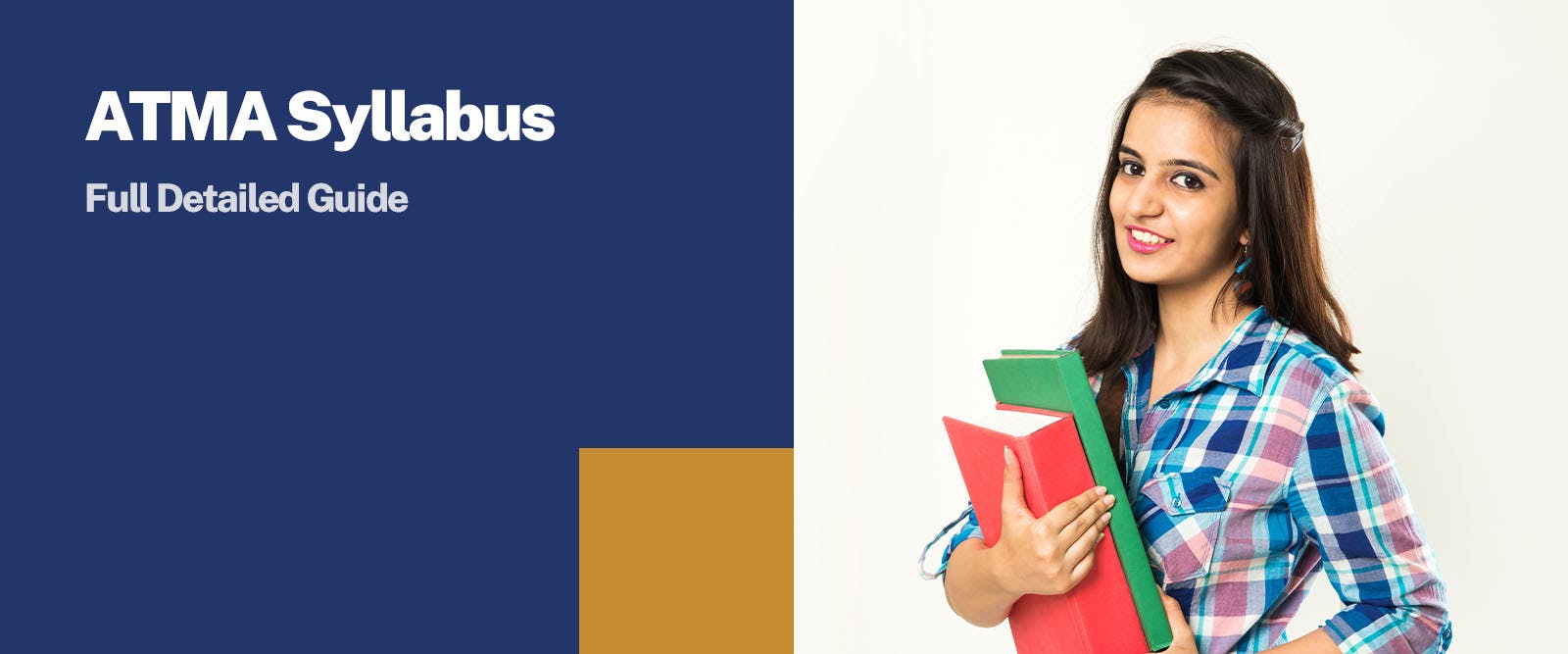5800 students unlocked their dream jobs with UG/PG programs in top colleges. Apply Now!
In the world of management education, the ATMA exam is one of the most common exams that students plan to take. This gives students the opportunity to get admission into India's most prestigious management institutes for their MBA degree. The first step that everyone thinks is of to get the knowledge of the exam’s syllabus, whether or not it fits their current curriculum. Not only this, knowledge of the exam syllabus allows students to focus and prepare the sections according to the scale of strength to weakness.
In this blog, we present a treasure mine of knowledge—a detailed guide to the ATMA syllabus. This guide will be your trusted companion, casting light on your path and empowering you to get success in the face of challenges.
ATMA Exam Overview
ATMA exam is a nation-level entrance exam conducted by the Association of Indian Management Schools (AIMS) for admission to various postgraduate management programs in India. Candidates who have just completed their bachelor’s and are preparing to start their career in management can give this exam.
ATMA Exam Highlight
|
Factors |
Information |
|
ATMA Full-Form |
AIMS Test for Management Admissions |
|
Mode of Exam |
Online |
|
Type of Exam |
Computer-based Test |
|
Medium of Exam |
English |
|
Maximum Time Allowed |
3 Hours |
|
Number of Sections |
3 |
|
Nature of Question |
Objective (MCQ) |
|
Options Count in MCQ’s |
4 |
|
Total Number of Questions |
180 |
|
Maximum Marks |
180 |
|
Negative Marking |
Yes |
ATMA Syllabus
|
Sections |
Skill Tests |
|
Quantitative Reasoning |
Skills I&II |
|
Analytical Reasoning |
Skills I&II |
|
Verbal Reasoning |
Skills I&II |
Quantitative Reasoning
This section tests the ability of a student to understand, interpret, analyse, and solve problems involving numerical and mathematical concepts. This section is an important section that evaluates a candidate's proficiency in mathematical skills and their ability to solve quantitative problems. Both the section, quantitative skills I and quantitative skills II, consists of the following topics:
- Arithmetic
- Modern Mathematics
- Number System
- Percentages
- Proportion and Ratio Variations
- Mensuration
- Quadratic Equation
- Algebra
- Geometry
- Average
- Profit and loss
- Time, Distance, and Speed
- Combination and Permutation
- Logarithm
- Number Systems
- LCM and HCF
- Inequalities
- Problem on Ages
- Complex Numbers
- Binomial Theorem
- Set Theory
- Surds and Indices
- Discounts
Preparation tips for Quantitative Reasoning:
- Understand the syllabus and make a list of the topics you need to focus on.
- Continuously review the basic concepts of the topics such as percentages, ratios, fractions, averages, profit and loss, time and distance, geometry formulas, and basic algebraic equations.
- Familiarise yourself with different problem-solving techniques and approaches. Learn various methods and shortcuts to solve mathematical problems efficiently.
Analytical Reasoning
This section tests the ability of students to gather, interpret, analyse, and evaluate information logically and systematically. It involves breaking down complex problems or situations into smaller components, identifying patterns or relationships, and drawing meaningful conclusions.
Analytical Reasoning skills consist of the following topics:
- Critical Reasoning
- Statement- Course of Action
- Statement- Inference
- Statement- Weak and Strong Arguments
Analytical Reasoning Skills II consists of the following topics:
- Coding-Decoding
- Strengthen/weak arguments
- Arrangements
- Syllogisms
- Statement-Conclusion
- Data Sufficiency
Preparation tips for Analytical Reasoning:
- Cultivate the habit of considering multiple perspectives on a given issue. Practice analysing different viewpoints, understanding their underlying assumptions, and evaluating their strengths and weaknesses.
- Solve puzzles, riddles, and brain teasers regularly to sharpen your analytical thinking. This will challenge your problem-solving abilities.
- Work on improving your data analysis skills by practising with real-life datasets. Analyse and interpret data using tools like spreadsheets or statistical software.
Verbal Reasoning
This section tests the ability of students to understand, analyse, and evaluate written information. It involves comprehending and interpreting written passages, identifying relationships between words and concepts, and drawing logical conclusions based on the given information. Both the section, verbal skills I and verbal skills II, consists of the following topics:
- Vocabulary
- Grammar
- Passages
- Jumbled Sentences
- Sentence completion
Preparation tips for Verbal Reasoning:
- Develop a habit of reading diverse materials such as books, newspapers, magazines, and online articles. This will expose you to different writing styles, topics, and perspectives.
- Use flashcards, vocabulary-building apps, or word lists to expand your word knowledge.
- Work on increasing your reading speed without compromising comprehension. Practice timed reading exercises to enhance your ability to absorb information quickly.
ATMA Exam Weightage
Given below is the table of exam weightage divided into three sections of the exam pattern that are further divided into six sub-sections.
|
Sections |
Number of Questions |
Total Marks |
||
|
I |
II |
I |
II |
|
|
Quantitative Reasoning |
30 Questions |
30 Questions |
30 Marks |
30 Marks |
|
Analytical Reasoning |
30 Questions |
30 Questions |
30 Marks |
30 Marks |
|
Verbal Reasoning |
30 Questions |
30 Questions |
30 Marks |
30 Marks |
|
Total of all Sections |
180 Questions |
180 Marks |
||
ATMA Exam Marking Scheme
It is important to keep the marking scheme in consideration since it gives an idea of how many questions and what kind of questions one should attempt to avoid negative marking. Given below is the marking scheme of the ATMA exam:
|
Marking Characteristic |
Marking Scheme |
|
Correct answer |
+1 mark |
|
Incorrect answer |
-0.25 mark |
|
Unattempted answer |
No mark |
Conclusion
The ATMA syllabus serves as a roadmap for aspiring management students, guiding them towards success in their pursuit of an MBA or PGDM program. By understanding the ATMA syllabus, candidates can align their preparation strategies effectively, ensuring they cover all the essential areas and maximise their chances of scoring well. Now you must be thinking of applying for an MBA program as you are going to appear in an MBA entrance exam. Well, you can apply with Sunstone and unlock numerous benefits that help you to shape your future. You get 70+ training and development sessions from top recruiters and industry experts. Also, if you appear in the Sunstone scholarship test, you can get a scholarship worth up to ₹ 10 Crore. You also learn from expert guest faculty that are ex-IIMs and IITs and 50+ guaranteed job interviews are aligned with Placement Protection Plan.
FAQs - ATMA Syllabus: Full Detailed Guide
How many months of preparation are needed to crack the ATMA exam?
Students should at least give a minimum of six months for ATMA exam preparation.
How much mark is deducted if a student attempts an incorrect answer?
If you attempt an incorrect answer then a 0.25 mark is deducted from your score.
How many times ATMA exam is conducted in a year?
The frequency of the ATMA exam is 4-5 times a year.
HELP
Take the first step towards your dream job.
ABOUT THE AUTHOR

